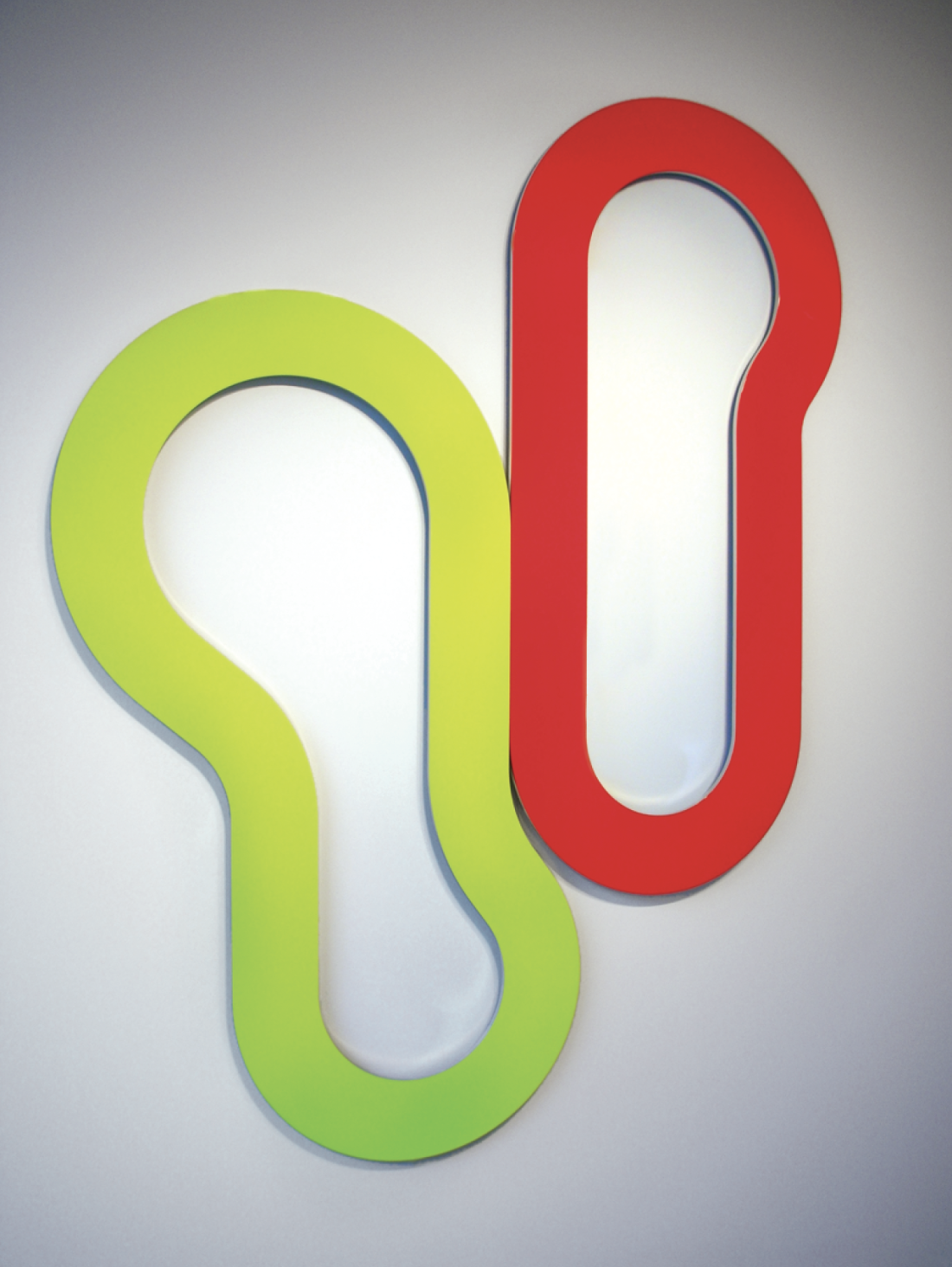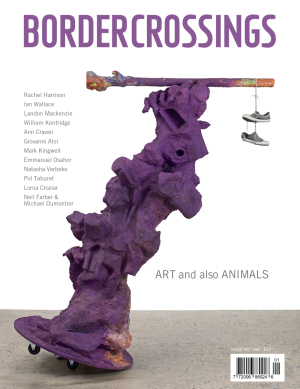Christian Eckart
Christian Eckart refers to himself as “absolutely a post-studio artist.” He pointed this out to me recently on the phone from his studio in Houston, Texas. He was referring, of course, to the fact that he doesn’t make work in his studio, but does, in fact, sit there and think things up. The work he makes is work he has fabricated—having recourse, in the case of his recent “Curved Monochrome” paintings and even more recent “Circuit Paintings,” to a number of labour-intensive automobile-finishing processes “developed by Rolls Royce wearily in the 20th century and based on the techniques of Chinese Lacquer Ware.”
This last is from an essay accompanying Eckart’s recent exhibition, “Pornopticon,” at the Clint Roenisch Gallery—his first solo exhibition in Toronto. It is in this same piece that Eckart states that he sees himself “working in the tradition of the Icon that includes artists such as Malevich, Mondrian, Newman and Ad Reinhardt.” It is here, too, that he concedes that in his preoccupation with “beauty, elegance, grace, simplicity, calm and sensuality,” he thereby works the terrain he refers to as the “Post-Romantic Sublime”—a deliciously precarious place to stand and to defend. He jokes ruefully on the phone about the impossibility, in an increasingly discredited, whitewestern- hetero culture, of “making monolithic gestures.” But, I counter (but, he counters), “there’s still longing.” Like Beckett, Eckart can’t go on/he goes on.
The Roenisch exhibition (I still don’t quite get the title “Pornopticon,” unless it was supposed to suggest a certain impropriety inherent in the viewing of so much bounded gorgeousness of colour and deep luminosity) was really a small anthology of Eckart’s works from the past decade, a miniature retrospective. It included five “Circuit Paintings” from 2005, two recent “Zootrope Paintings”—a series of explorations he has been working on for a decade—and three “Veil Paintings” from 1991.
The “Circuit Paintings,” one a diptych and the other four resolute singularities (though designed in such a way as to suggest the imminent possibility of their pulling themselves apart, amoeba-like, into a new two-ness), are wall-mounted panels of fluorescent acrylic urethane on aluminium, shaped like slot-car racing tracks or, as Eckart suggests, like the shape of electric circuitry itself (“painting should make the eye move,” he says; “in the “Circuit Paintings,” I was playing with the idea of things that look as if they’re switched on.”).

Christian Eckart, Circuit Painting (Dyptich), 2005, acrylic urethane on aluminium, 72 x 56 x 2”, 2 components. Photo: Clint Roenisch. Courtesy Clint Roenisch Gallery, Toronto.
That switched-on look is the result of a number of intricate and exacting processes, reminiscent, in their final effect, of the obsessive care lavished by their builders on the bodies of Kustom Kars. The paintings—or painting-objects— begin as sheets of half-inch aluminium plate, which then undergo what Eckart refers to as a “very specific paint protocol” involving four coats of pigment (“which behaves more like ink than paint”), a couple of layers of hand-polished epoxy primer, then four separate passes of clear-coating (a coat is called a “pass”) and then more hand polishing. The colour that results from these almost alchemically detailed processes has a palpability, a presence, that not only covers the shaped object upon which it is lavished but seems to float free as a sort of coloured fragrance you can not only look at but encounter. The colour in the “Circuit Paintings” is so primary, so numinous as well as luminous, it tends to make the carefully devised rudimentary shapes of the paintings seem incidental rather than morphologically authoritative: it is colour that reigns over these circuitous sites.
The “Zootrope Paintings,” by contrast, are scarcely paintings at all in the sense that they don’t involve paint per se. Basically, each work consists of a mirror-polished sheet of aluminium, into which has been cut a system of holes. In the earlier works, Eckart points out, the holes were “flat”—that is to say, they were cut straight and round into the metal surface and read like orthodox moments of punctuation. The new, more complex “Zootropes” offer fields of shaped holes, the complex ovals generated by computer so that they appear to warp and flex the picture plane, offering curvature on flatness, depth in tautness. They offer, in other words, a fictive surface, illusionism, a contradictory opticality that is as disturbing as it is elating. “These Zootropes are the dumb ones,” Eckart tells me. “These are the ones you have to make at the beginning of an idea.” I’d call them brash, not dumb, but I know what he means. “I want them to be artworks by default,” says Eckart. “For example, there are a lot of things they aren’t” (they aren’t useful, for example). Which frees them into the realm of the contemplative, even though their mirrored surfaces reflect the viewer and the room where they are being viewed, thus impurely welcoming, at the same time, spates of viewer-narcissism and all sorts of other psychological, architectural and quasi-mythical issues into the experiential theatres they provide.
The “Veil Paintings,” part of Eckart’s tenacious “Shadow Paintings Project,” begun in 1990, are based on his employment of the “aging technology” of the harvesting of broadcast and commercial video images, which are then selected, freeze-framed, made into video prints, cropped, rephotographed with an 8-by-10 view camera, transformed into four-colour offset prints, which are made into silkscreen prints (overprinted several times), which are transfixed, one might say, onto an aluminium panel using Mercedes-Benz epoxy primer and then printed in epoxy ink. I think I have that right, but I might be wrong in the details or the order of events. But one thing is for sure: the image, as Eckart notes, “is really truly veiled.” And veiling, he points out, is arguably part of the history of sublimity. The “Veils,” Eckart maintains, are a corollary to the rest of his work in that they “strive to identify the location of the transcendental in popular consciousness.” As with all modernist painting, they work to evoke whatever is wired into the consciousness of the percipient. “Which, of course,” says Eckart with a certain mock ruefulness, “is now completely suspect.” ■
“Pornopticon” exhibited at the Clint Roenisch Gallery in Toronto, Ontario, from November 4 to December 18, 2005.
Gary Michael Dault is a critic, poet and painter who lives in Toronto.

